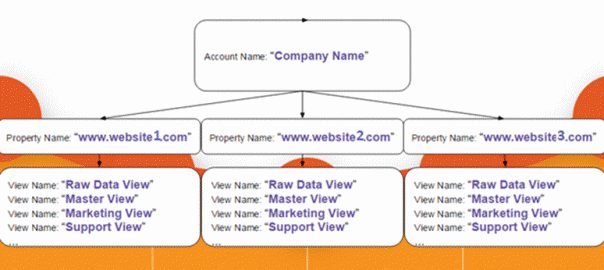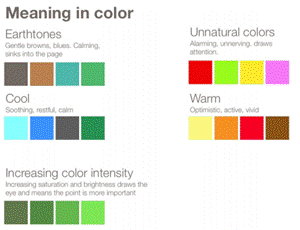
Want to manage your digital analytics accounts like a pro? Here is what I have learned in five years.
Contents
- Keep It Simple
- Documentation
- Implementation
- Tagging tools
- Digital analtyics tools
- Google Analytics best practices
- Google Tag Manager best practices
- Tagging tools
- Clean data & reports
I. Keep It Simple
The sheer amount of available information adds a layer of complexity to a world that is already complex.
Most of our online and offline interactions leave behind digital footprints (that we call data), and it’s increasingly harder to find the right information within this tsunami of data. To find meaning.
As Digital Analytics experts, we make things simple by translating the complexity into simple graphs, phrases, insights, and recommendations.
How is this done? At a basic level, there are four simple steps:
1. Choose the right tool for the right mission
Clean data simplicity starts with the tools. Try as much as you can to use the simple tools already available.
Use each tool according to their strengths:
- Google Analytics: famous, free, simple, and well supported tool. Even with other tracking installed, many analysts have Google Analytics implemented in parallel.
- Google Tag manager: manage all your tags (Marketing and Analytics) in one place.
- Segment.io: collect customer data with one API and send it to hundreds of tools for analytics, marketing, and data warehousing.
- Weelytics: a visual tracking tool where you can tag your website key metrics without coding.
Usually, you use multiple tools and combine them for maximum benefit. For example, combining Google Analytics & Google Tag Manager will help you to manage and govern your analytics tags. On the other hand, Google Analytics & Weelytics is the quickest and easiest way tag your website metrics without coding. Or, why not to take the best of the two worlds of Google Tag Manager & Segment IO?
You got it! ?
2. Define & Start with the end in mind
We try to build and maintain a Digital analytics strategy that responds to multiple questions from multiple stakeholders.
To that end, we have to start with the end in mind; always set priorities regarding to the organization’s goals.
Start by meeting with the business and marketing stakeholders. Bring a couple of questions; as what are their existent key metrics, key segments of visitors. What other information’s could be helpful? Do you have some suggestions?
After doing this, you know your scope, so you can easily focus to deliver a valuable outcome.
3. Categorize
Set your conversion points and group them together.
The best simplest method of categorizing conversions is to divide them into macro and micro conversions:
Macro Conversions: Also called the outcomes. These are the reason for which your website exists. The total number of orders submitted if you sell stuff. The total number of leads collected if that’s what your site does. The number of donations if your site is a charity; ad clicks if you’re running an ad-supported website.
Micro Conversions: Any step along the way that supports the macro conversions. Some micro conversions: the number of times the Print This Page option was selected, newsletter signups, a specific video was viewed, etc.
4. Focus
Remain focused on the key: conversions (Goals).
Make a short list of conversions and describe each in simple terms so they can be shared with anyone in the organization. Message that we focus on improving these goals through everything that we do.
Don’t forget that our ultimate goal is to obtain insights from conversions.
II. Good Documentation
Analytics tagging must be updated constantly to keep up with site changes, fixes, and new optimization opportunities. It is important to have the developer resources that can make changes quickly. At one point you won’t be there; you moved on to another client, another company, or you’re down for a few weeks due to illness or vacation.
In your place there should be clear documentation that describes what data is focused on why (see above) but also how this is technically captured. Which events are tracked where and how? Is there remarketing code on a page somewhere? Which page?
To this purpose use a data dictionary or solution design document. Think about an Excel document that has information about the setup and the variables used. Each tab can focus on a type of information.

For the full version, this template is available for download — feel free to use it: Solution Design Document Template
III. Solid Implementation
Before you can answer the question you have to ask: can we trust the data?
Check the implementation; can you trust it?
- Are all our properties tagged?
- Do we need subdomain tracking?
- What about cross domain tracking?
- Are all pages tagged?
- Do we use the right variables to track the right information?
- Are events firing?
- Do we have (relative) values assigned to goals?
In the rest of this post, I use the two most used tools — Google Analytics and Google Tag Manager — as examples. But of course there are other solutions available:
Tagging Tools:
- Google Tag Manager
- Dynamic Tag Management: Adobe Tag Management Tool
- Tealium: Tag Management Tool
- Weelytics: Web site visitors tracking and Visual Tagging Tool
Digital Analytics Tools:
- Adobe Analytics: Expensive and does more than you can imagine.
- Google Analytics: Tracks everything for free.
- KISSmetrics: I love it’s user-centric analytics philosophy. Futurist and different than Google Analytics
Google Analytics Best Practices
To get the Maximum of Google Analytics, start by setting up a nice account architecture. It starts by using your company name as the account name, your website name as a Property name, and using different views for different versions of your data.
E.g.:
- Master view: Used for analysis that will contain filters and custom configurations.
- Raw data view (UNFILTERED): This will have your website traffic raw data. You can consider it as a Back-up.
- Test view: It collects the dev website data.
Always having a raw data view on Google Analytics is an absolute best practice! It will store the original (not modified) collected information’s. This view could be used to see historical information and as a backup if any filtering issues corrupt data.
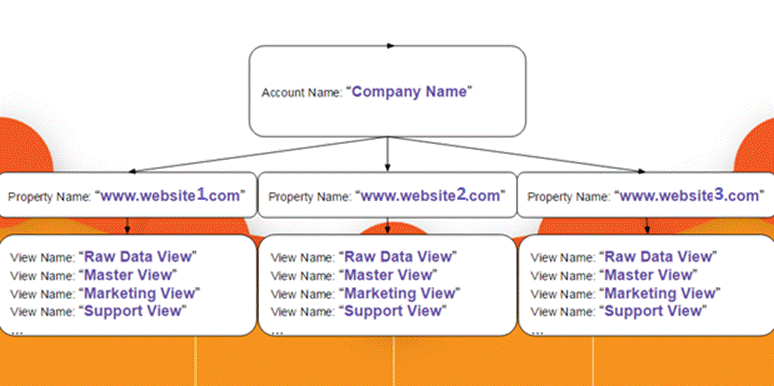

Give access to the right persons and ensure you walk your team members through the best practices document.
You can give access:
- By Account.
- By Property.
- By View.

And, each level have 4 types of accesses; take advantage of them all  :
:

Train yourself, to use the same variables naming convention for your analytics dimensions, metrics and events cross properties, views and accounts.
Setup Google Analytics Alerts to get notified of alarming events that indicate tagging & tracking is failing. E.g.:
- 90% weekly increase/decrease in visits.
- 90% weekly increase/decrease in conversion rate and/or value for each goal.
- 90% weekly increase/decrease in Ecommerce revenue.
Use annotations to describe and keep historical records of things like design changes, outages, marketing initiatives…
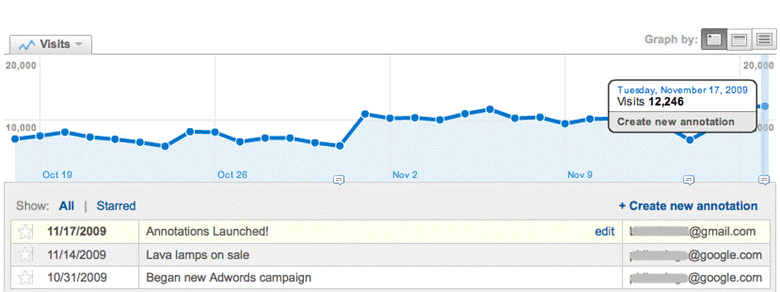
If you are a beginner, feel free to read this absolute beginner’s guide to Google Analytics by the well-known Kristi Hines.
Google Tag Manager Best Practices
- Use the company name as the GTM account name. Use the website names as the containers names. Always use separate accounts for each client.
- Use the “where, how and what is tracked” strategy to name your tags. This will help to identify your tags by yourself and other team members. E.g.:
- Tag name: “UA – Event – Newsletter Registration”.
- Tag name: “FB – Conversion pixel – Newsletter registration”.
- Tag name: “UA – Event – Newsletter Registration”.
- Use Google Tag Manager for all the website’s tags. Try not to combine with in page JavaScript Tags or, worse, with other tag managers.
Do not forget to test, test and re-test your tags before deploying  . Test on mobile, test on different browser and be aware of custom HTML tags. An awesome feature from Google Tag Manager is is the Debugging mode. Take advantage of it to test the Tags before publishing. (See also: Debugging Tag Execution Properly)
. Test on mobile, test on different browser and be aware of custom HTML tags. An awesome feature from Google Tag Manager is is the Debugging mode. Take advantage of it to test the Tags before publishing. (See also: Debugging Tag Execution Properly)
Finally, regarding technical tagging, if you have more time and you feel you are more experienced feel free to look at my technical blog post The Blue Layer: Tags on page and collection
IV. Clean Data & Reports
After implementing and collecting, it’s time to present the information and insights.
Dashboards and Reports Best Practices
This is where we will share our results and hard working. Yes, it’s time to deliver and share the awesomeness.
Design your dashboards and reports with a goal in mind. Start asking the “why” questions. Why am building this report? What is the purpose?
Ask these questions:
- Timeliness: How frequently is the data in the dashboard updated?
- Connectivity: Does the dashboard need to connect to live data sources?
- Data detail: Will the dashboard offer the ability to drill down to see more context?
- Data density: How information-rich will views of the data be?
- Interactivity: Will the user benefit from interacting with the dashboard?
The metrics you use are important. Use Understandable, Actionable and Accessible metrics to build your reports. Provide context. Always present performance measured against clear goals.
When it comes to formatting, it’s nice to choose the right Chart types for your information and goals. Choose colors for meanings:
Analyse and write insights that call the reader to make decisions.
Want to know what not to do? Check the ugliest dashboards list ever existed here :-D.
Reporting Tips
You should re-design your dashboard if it looks like this:
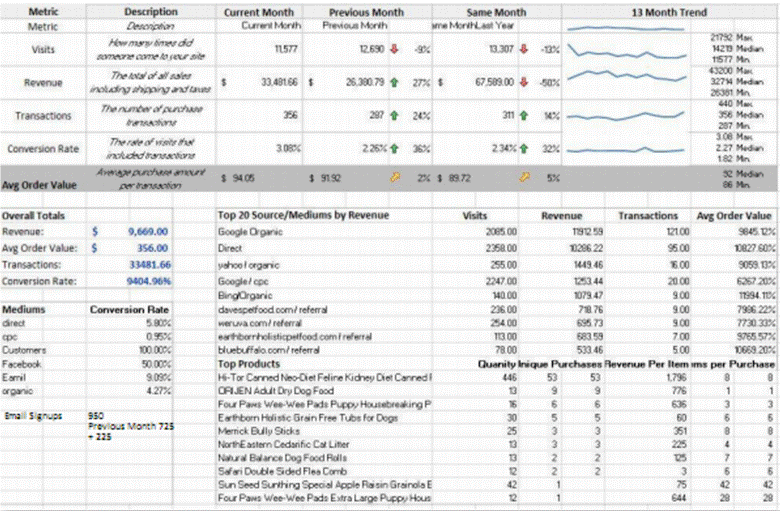
Why?
- No Insights available: the report has zero analysis, Insights or recommendations.
- There is no logical design the eyes can follow
- Not enough meaningful colors to help guide understanding or grouping
Now, let’s share two nice example.:
PS: Some of the examples were shared previously by an Analytics evangelist, Avinash Kaushik: Digital Dashboards: Strategic & Tactical: Best Practices, Tips, Examples.
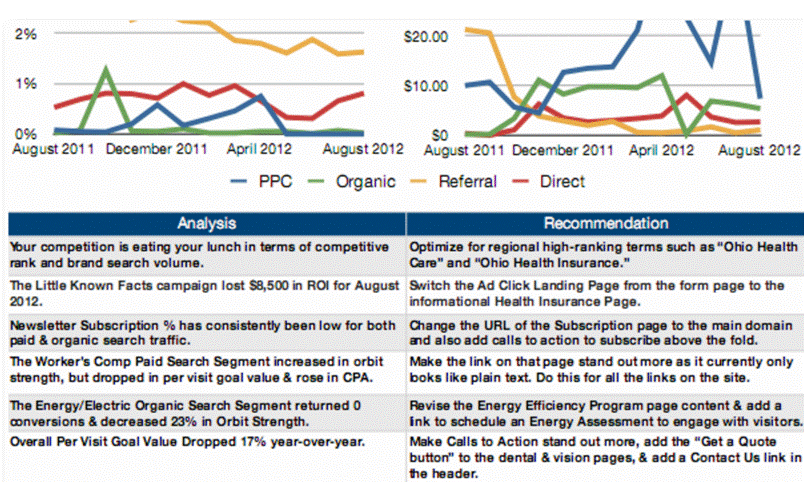
What is awesome here?
- I love the clean colors and their descriptions.
- Well-designed dashboard. A page divided 50% / 50%.
- Analysis and recommendation. The WHY!
What about the following? A Behavior Strategy dashboard:
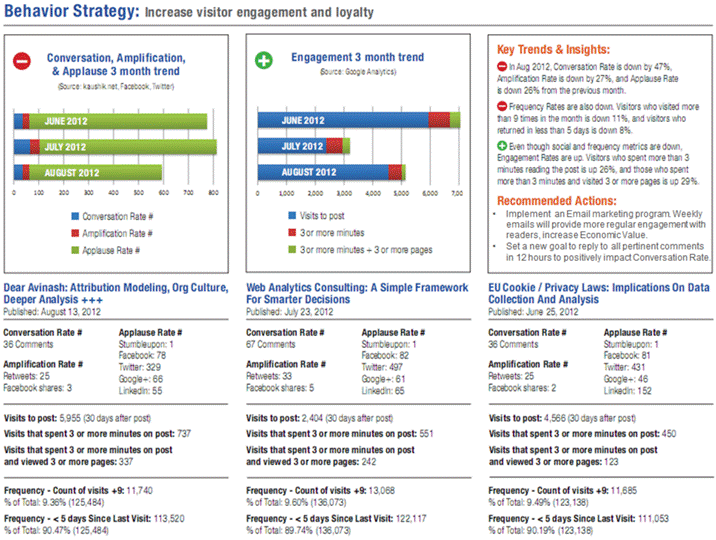
Why I love it?
- Clean colors and their descriptions.
- Well-designed dashboard. A page divided by 33% / 33% / 33%.
- No mixed numbers
- Key Trends and Insights and recommended actions. The WHY!
I hope after this list and examples, my friends, you found the “why” behind all this. Do you think about other best practices?
Hand-Picked Related Articles:
- How To Get Data For A Specific List Of URLs In Google Analytics
- How To Filter Out Google Analytics Event Tracking Spam
- How To Use Landing Pages In Google Analytics To Find Keywords
* Adapted lead image: ![]() Some rights reserved by KamiPhuc
Some rights reserved by KamiPhuc
The Starters Setup Guide To Digital Analytics
The post The Starters Setup Guide To Digital Analytics appeared first on Search Engine People Blog.
Search Engine People Blog(74)
